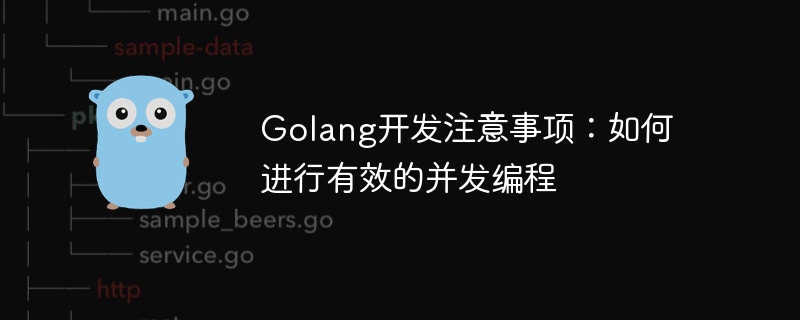
Golang is an open source programming language developed by Google and first released in 2009. It is a statically typed language with efficient memory management and concurrency support, suitable for building high-performance network services and distributed systems. In Golang, concurrency is a very important feature, which allows us to perform multiple tasks at the same time, thereby improving the performance and responsiveness of the program. However, concurrent programming also has some challenges, and this article will introduce some considerations for effective concurrent programming in Golang development.
- Use Goroutine for concurrent operations: Goroutine is a lightweight thread in Golang that has very low overhead and efficient concurrent execution. By using Goroutine, we can easily set a function or method to execute concurrently without manually creating threads. In actual programming, you can use the go keyword to create a Goroutine, for example: go func() {...}. However, it should be noted that Goroutines are relatively cheap to create and destroy, so a large number of Goroutines can be created to perform tasks concurrently.
- Use channels for data communication: In concurrent programming, data synchronization and sharing is a key issue. Golang provides Channel to solve this problem. Channel is a special type in Golang, which can be used to transfer data between different Goroutines. By using channels, we can share data safely and avoid problems such as data races and deadlocks. In Golang, you can use the make function to create a channel, for example: ch := make(chan int). We can then use the
- Avoid Shared State: A common pitfall in concurrent programming is shared state. When multiple Goroutines access and modify the same variable at the same time, problems such as race conditions and data competition will occur. Therefore, to avoid these problems, we should try to avoid shared state. In Golang, you can use a mutex (Mutex) to protect shared variables. By using a mutex, we can ensure that only one Goroutine can access the shared variable at the same time. For example: before accessing a shared variable, you can use sync.Mutex to lock it, and then release the lock after the access is completed.
- Use WaitGroup to wait for all Goroutines to complete: In concurrent programming, sometimes we need to wait for all Goroutines to complete before proceeding to the next step. Golang provides a mechanism called WaitGroup to solve this problem. WaitGroup is a counter that will reset to zero when all Goroutines are completed. We can use the Add, Done and Wait methods of WaitGroup to control the count. After each Goroutine completes, the Done method can be called to decrement the count. In the main Goroutine, you can call the Wait method to wait for all Goroutines to complete. For example: you can use var wg sync.WaitGroup to create a WaitGroup, then call wg.Add(1) in each Goroutine to increment the count, and finally call wg.Wait() in the main Goroutine to wait for all Goroutines to complete.
- Use a timer or timeout mechanism: In concurrent programming, sometimes we need to set a time limit for an operation to prevent it from falling into infinite waiting or long-term blocking. Golang provides a tool called time package to handle this problem. We can use the Timer structure in the time package to set the timer, and then use the select statement and channel to wait for the timer event. Another way is to use the timeout mechanism in the context package. By creating a context object with a timeout, we can perform an operation within the specified timeout and then cancel the operation when the timeout occurs. This prevents the program from blocking or deadlocking for long periods of time.
Through the above points, we can carry out effective concurrent programming in Golang development. Concurrent programming can improve program throughput and performance and make full use of the capabilities of multi-core processors. However, concurrent programming also has some difficulties and challenges that require careful handling and compliance with some norms. I hope this article will be helpful to Golang developers when doing concurrent programming.
The above is the detailed content of Golang development notes: How to do effective concurrent programming. For more information, please follow other related articles on the PHP Chinese website!






